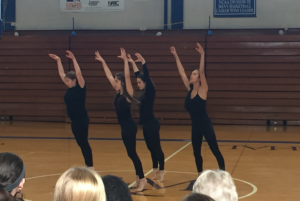By Christa Rodriguez || Campus Life Editor

This past week’s Common Hour featured the F&M Dance Company, incorporating both lecture and performance into the presentation, with a focus on dance as a way of knowing. Pam Vail, Associate Professor of Dance, and Jennifer Conley, Assistant Professor of Dance, both spoke on dancing knowledge and introduced the dances performed by the students.
Vail opened the Common Hour by presenting the dilemma of “talking about something that’s inherently nonverbal,” which is dance. She noted that intelligence does not reside solely within the brain. The rest of the body can hold wisdom and express knowledge, from social to sensual.
Vail said she has always been drawn to movement, and “moving as a way of knowing. It is knowing.” She brought up body-mind centering, or BMC, which is the notion that the body moves as the mind moves. Movement is crucial to knowing in this practice, and acknowledging that every body has wisdom. And through movement, one can access that intelligence.
Dance, Vail said, is not simply entertainment but also a way of interacting with the environment and knowing the world. Dancers can develop an understanding of themselves and their own bodies, which helps them better understand others, which assists in empathy. In fact, Vail noted how some schools use movement to teach empathy, while some studies have also shown how dance improves test scores. Yet, dance is not taught in many public schools. When dancing, Vail stated, instead of turning off your mind, you instead use it differently through nonverbal knowledge. In turn, moving can help one understand different types of verbal knowing, such as science and history.
Jennifer Conley continued with the notion of dance as a way of knowing. She started by comparing choreography and dance. While choreography is a structured design that can be copyrighted, dance exists in the moment. While dance can be described by reviewers or captured by video and pictures, these do not “represent the complete phenomenon of dance.”
Given the ephemeral nature of dance, Conley discussed ways in which people can keep dance alive. Dance reconstruction is one way, as the people doing the reconstructing can go through videos, visuals and written accounts of the dance to reconstruct it. In this way, the dancers become “living archives.” F&M has a tradition of reconstructing and archiving dances by great artists. An example of this was the excerpt the F&M Dance Company performed that claimed not to be a reconstruction, but rather, a reimagining, of a dance originally by Isadora Duncan from 1904. F&M’s version was titled “Pandora and the Furies.” They also performed an excerpt of “Panorama,” a restaging of a work by Martha Graham.
Conley also discussed movement as cultural knowledge too. She said, “movement embodies cultural knowledge” through information such as when people within a culture dance, how they dance, who they dance with, and more. Cultural ideas become visible through the movements. This was exemplified by the Dance Company’s third performance, an excerpt of an Afro-Latin dance.
Vail talked about how people read movement during daily interactions as well as in dance. Dance “disrupts our habitual ways of knowing and seeing,” she said. As a choreographer, Vail says she starts by moving, as “the doing” becomes the research. Another excerpt performed was titled “The Traveling Tribe of the Wrinkled Skirts,” by Pam Vail herself. Lastly, Vail spoke on accessing attention and awareness through movement and “thinking in motion,” which was demonstrated by an improvisational dance performance. Emily Germani ’18, Dance and Anthropology major at F&M, also presented briefly about her research on why people dance on campus.
The performances at Common Hour were excerpts of larger works that will be performed in full at the Fall Dance Concert in Roschel Performing Arts Center November 30 – December 2, 7:30pm Thursday and Friday, and 7pm on Saturday.
Junior Christa Rodriguez is the Campus Life Editor. Her email is crodrigu@fandm.edu.